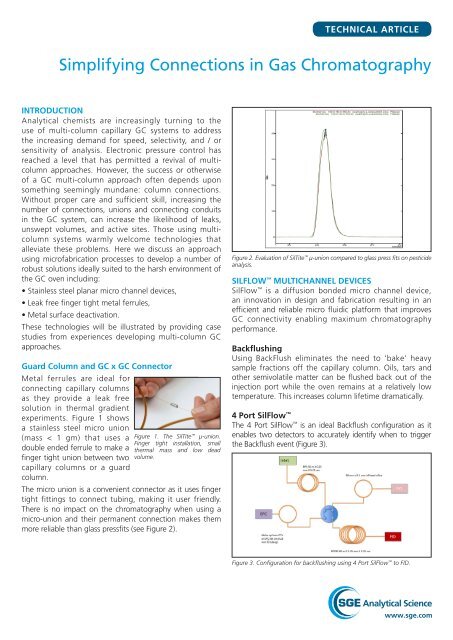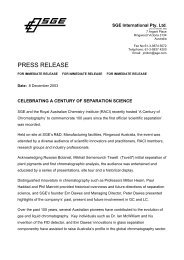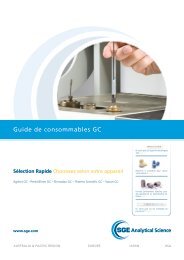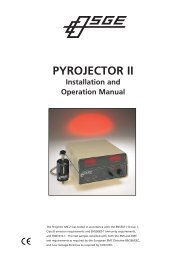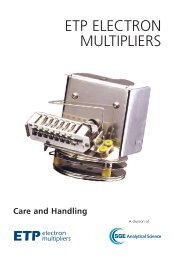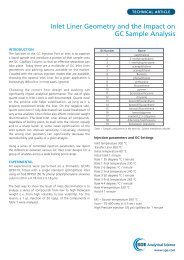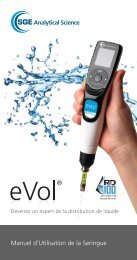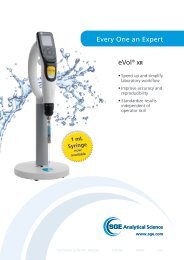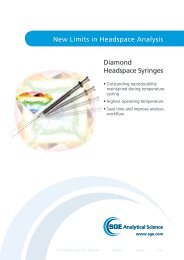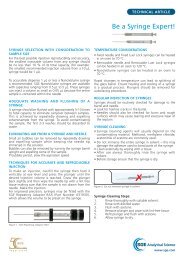Simplifying Connections in Gas Chromatography - SGE Analytical ...
Simplifying Connections in Gas Chromatography - SGE Analytical ...
Simplifying Connections in Gas Chromatography - SGE Analytical ...
Create successful ePaper yourself
Turn your PDF publications into a flip-book with our unique Google optimized e-Paper software.
TECHNICAL ARTICLE<br />
<strong>Simplify<strong>in</strong>g</strong> <strong>Connections</strong> <strong>in</strong> <strong>Gas</strong> <strong>Chromatography</strong><br />
INTRODUCTION<br />
<strong>Analytical</strong> chemists are <strong>in</strong>creas<strong>in</strong>gly turn<strong>in</strong>g to the<br />
use of multi-column capillary GC systems to address<br />
the <strong>in</strong>creas<strong>in</strong>g demand for speed, selectivity, and / or<br />
sensitivity of analysis. Electronic pressure control has<br />
reached a level that has permitted a revival of multicolumn<br />
approaches. However, the success or otherwise<br />
of a GC multi-column approach often depends upon<br />
someth<strong>in</strong>g seem<strong>in</strong>gly mundane: column connections.<br />
Without proper care and sufficient skill, <strong>in</strong>creas<strong>in</strong>g the<br />
number of connections, unions and connect<strong>in</strong>g conduits<br />
<strong>in</strong> the GC system, can <strong>in</strong>crease the likelihood of leaks,<br />
unswept volumes, and active sites. Those us<strong>in</strong>g multicolumn<br />
systems warmly welcome technologies that<br />
alleviate these problems. Here we discuss an approach<br />
us<strong>in</strong>g microfabrication processes to develop a number of<br />
robust solutions ideally suited to the harsh environment of<br />
the GC oven <strong>in</strong>clud<strong>in</strong>g:<br />
• Sta<strong>in</strong>less steel planar micro channel devices,<br />
• Leak free f<strong>in</strong>ger tight metal ferrules,<br />
• Metal surface deactivation.<br />
These technologies will be illustrated by provid<strong>in</strong>g case<br />
studies from experiences develop<strong>in</strong>g multi-column GC<br />
approaches.<br />
Guard Column and GC x GC Connector<br />
Metal ferrules are ideal for<br />
connect<strong>in</strong>g capillary columns<br />
as they provide a leak free<br />
solution <strong>in</strong> thermal gradient<br />
experiments. Figure 1 shows<br />
a sta<strong>in</strong>less steel micro union<br />
(mass < 1 gm) that uses a<br />
double ended ferrule to make a<br />
f<strong>in</strong>ger tight union between two<br />
capillary columns or a guard<br />
column.<br />
Figure 1. The SilTite µ-union.<br />
F<strong>in</strong>ger tight <strong>in</strong>stallation, small<br />
thermal mass and low dead<br />
volume.<br />
The micro union is a convenient connector as it uses f<strong>in</strong>ger<br />
tight fitt<strong>in</strong>gs to connect tub<strong>in</strong>g, mak<strong>in</strong>g it user friendly.<br />
There is no impact on the chromatography when us<strong>in</strong>g a<br />
micro-union and their permanent connection makes them<br />
more reliable than glass pressfits (see Figure 2).<br />
Figure 2. Evaluation of SilTite µ-union compared to glass press fits on pesticide<br />
analysis.<br />
SILFLOW MULTICHANNEL DEVICES<br />
SilFlow is a diffusion bonded micro channel device,<br />
an <strong>in</strong>novation <strong>in</strong> design and fabrication result<strong>in</strong>g <strong>in</strong> an<br />
efficient and reliable micro fluidic platform that improves<br />
GC connectivity enabl<strong>in</strong>g maximum chromatography<br />
performance.<br />
Backflush<strong>in</strong>g<br />
Us<strong>in</strong>g BackFlush elim<strong>in</strong>ates the need to ‘bake’ heavy<br />
sample fractions off the capillary column. Oils, tars and<br />
other semivolatile matter can be flushed back out of the<br />
<strong>in</strong>jection port while the oven rema<strong>in</strong>s at a relatively low<br />
temperature. This <strong>in</strong>creases column lifetime dramatically.<br />
4 Port SilFlow <br />
The 4 Port SilFlow is an ideal Backflush configuration as it<br />
enables two detectors to accurately identify when to trigger<br />
the Backflush event (Figure 3).<br />
Figure 3. Configuration for backflush<strong>in</strong>g us<strong>in</strong>g 4 Port SilFlow to FID.
TECHNICAL ARTICLE<br />
Figure 4 demonstrates the analysis of ethanol, benzene and<br />
toluene <strong>in</strong> gasol<strong>in</strong>e on a polar BPX90 capillary column. The<br />
sample was first run on a nonpolar BP1 to identify the time<br />
where the Backflush is <strong>in</strong>tiated to prevent the non-volatile<br />
runn<strong>in</strong>g onto the BPX90 column.<br />
Figure 4 A, separation of gasol<strong>in</strong>e on BP1 (30 m x 0.25 mm<br />
x 0.25 µm, P/N 054044) and BPX90 (60 m x 0.25 mm x<br />
0.25 µm, P/N 054590) with 2-Butanol IS.<br />
Figure 4 B, separation of gasol<strong>in</strong>e on BP1 (30 m x 0.25 mm<br />
x 0.25 µm) and BPX90 (60 m x 0.25 mm x 0.25 µm) with<br />
Backflush triggered at 2 m<strong>in</strong>utes - note the absence of the<br />
semi-volatiles post 10 m<strong>in</strong>utes.<br />
A)<br />
Figure 4. Backflush method - gasol<strong>in</strong>e on BP1 and BPX90 FID Data split with<br />
MS with 2-Butanol IS.<br />
3 Port SilFlow <br />
The 3 Port SilFlow is ideal<br />
for detector splitt<strong>in</strong>g, column<br />
splitt<strong>in</strong>g and also functions<br />
<strong>in</strong> Backflush mode. In natural<br />
gas analysis it is preferred to<br />
backflush if water is present<br />
- the follow<strong>in</strong>g examples<br />
demonstrate mercaptans<br />
spiked <strong>in</strong>to nitrogen.<br />
Figures 5 and 7 illustrate the Backflush set-up for the<br />
3 Port SilFlow us<strong>in</strong>g two different detection systems - FID<br />
and SCD (Sulphur Chemilum<strong>in</strong>escence Detector) for the<br />
analysis of mercaptans <strong>in</strong> natural gas. Figure 6 highlights<br />
the excellent peak shape for the different mercaptans<br />
<strong>in</strong> the FID set-up. While slight peak tail<strong>in</strong>g is obvious <strong>in</strong><br />
Figure 8 for the low ppm levels, this is due to the nonspecific<br />
<strong>in</strong>teractions <strong>in</strong> the detector (alpha-alum<strong>in</strong>a). Figure<br />
9 shows a commercial natural gas sample run us<strong>in</strong>g the<br />
3 Port SilFlow set-up highlight<strong>in</strong>g the chemical <strong>in</strong>ertness<br />
and detection of the sulphur odorants.<br />
B)<br />
3 Port SilFlow <br />
Figure 5. Configuration for backflush<strong>in</strong>g us<strong>in</strong>g 3 Port SilFlow to FID.<br />
1. Methyl mercaptan<br />
2. Ethyl mercaptan<br />
3. Propyl mercaptan<br />
4. Butyl mercaptan<br />
Figure 6. 100 ppm (v/v) methyl, ethyl, propyl, butyl mercaptans <strong>in</strong> nitrogen<br />
by GC/FID.<br />
Figure 7. Configuration for backflush<strong>in</strong>g us<strong>in</strong>g 3 Port SilFlow to SCD.<br />
1. Methyl mercaptan<br />
2. Ethyl mercaptan<br />
3. Propyl mercaptan<br />
4. Butyl mercaptan<br />
Figure 8. 1 ppm (v/v) of methyl, ethyl, propyl and butyl mercaptan <strong>in</strong> nitrogen<br />
GC/SCD.
TA-0150-A © <strong>SGE</strong> <strong>Analytical</strong> Science Pty Ltd 07/2012<br />
TECHNICAL ARTICLE<br />
GC: Agilent 6890N with split/Splitless <strong>in</strong>let at 250 °C, Focusl<strong>in</strong>er, split ratio 5:1<br />
Detector: Agilent Dual-plasma sulphur chemilum<strong>in</strong>escence detector<br />
Reactor temperature: 850 °C<br />
Hydrogen: 50 mL/m<strong>in</strong> Air: 35 mL/m<strong>in</strong><br />
Reactor vacuum: 310 torr<br />
Ozone reactor vacuum: 10 torr, 5 psig air<br />
Oven profile: 40 °C (2m<strong>in</strong>) – 15 °C/m<strong>in</strong> – 200 °C - 5m<strong>in</strong><br />
1. Methyl mercaptan (trace)<br />
2. Dimethyl sulphide (500 ppb)<br />
3. Methyl ethyl sulphide (200 ppb)<br />
Figure 9. Commercial Alberta Natural <strong>Gas</strong>.<br />
Heart Cutt<strong>in</strong>g with SilFlow Deans’ Switch<br />
Heart cutt<strong>in</strong>g is regularly used <strong>in</strong> multidimensional GC<br />
where a time slice of the elute from a separation <strong>in</strong> the<br />
first dimension is directed onto a second capillary column<br />
of an alternate stationary phase (the second dimension).<br />
Figures 10 and 11 demonstrate a simple example where<br />
the co-elut<strong>in</strong>g peaks of Octenyl Acetate and L<strong>in</strong>alool<br />
L were ‘heart cut’ from the non-polar BPX5 onto the<br />
polar BPX70 highlight<strong>in</strong>g the separation of both these<br />
compounds from Lavender Oil.<br />
P/N 054101<br />
For more <strong>in</strong>formation contact our technical customer support team at techsupport@sge.com<br />
AUSTRALIA & PACIFIC REGION<br />
<strong>SGE</strong> <strong>Analytical</strong> Science Pty Ltd<br />
Toll Free: 1800 800 167<br />
Tel: +61 (0) 3 9837 4200<br />
Fax: +61 (0) 3 9874 5672<br />
Email: support@sge.com<br />
JAPAN<br />
<strong>SGE</strong> Japan Inc<br />
Tel: +81 45 222 2885<br />
Fax: +81 45 222 2887<br />
Email: japan@sge.com<br />
Lavender Oil,<br />
Method: 60 °C, 1 m<strong>in</strong>, 3 °C/m<strong>in</strong> up to 140 °C,<br />
5 °C/m<strong>in</strong> up to 260 °C<br />
FID-280 °C, INJ-250(228) °C, split vent flow 285 mL/m<strong>in</strong>,<br />
0.1 µL <strong>in</strong>jection<br />
P/N 054622<br />
Figure 10. Configuration for heart cutt<strong>in</strong>g us<strong>in</strong>g Deans’ Switch SilFlow to dual FID.<br />
A)<br />
Figure 11. Lavender Oil heart cutt<strong>in</strong>g results.<br />
A) Lavender oil separated on the first dimension BPX5 column - note the<br />
coeultion of octenyl acetate and L<strong>in</strong>alool L.<br />
B) Separation of the BPX5 ‘heart cut’ on BPX70, C) Separation of the rema<strong>in</strong><strong>in</strong>g<br />
lavender oil components on BPX5.<br />
CONCLUSION<br />
• Sta<strong>in</strong>less steel planar microchannel devices provide a<br />
versatile format for multidimensional analysis.<br />
• Each of the metal devices described are optimized for<br />
low thermal mass.<br />
• The chemical surface treatment of the channel devices<br />
and f<strong>in</strong>ger tight fitt<strong>in</strong>gs do not impact chromatography<br />
– even for sulphur conta<strong>in</strong><strong>in</strong>g analytes.<br />
• F<strong>in</strong>ger tight fitt<strong>in</strong>gs provide robust and easy to use<br />
column connectors, simplify<strong>in</strong>g connections <strong>in</strong> the GC.<br />
• Multi-channel fabricated devices simplify column<br />
splitt<strong>in</strong>g, backflush<strong>in</strong>g and heart cutt<strong>in</strong>g.<br />
REFERENCES<br />
1) Mr Okawa (Bruker - Japan) Micro Union comparison<br />
with Glass Press Fit<br />
2) J Luong, R. Gras, R.A. Shellie, H. Cortes – manuscript<br />
<strong>in</strong> preparation. For data on the 3 Port SilFlow work.<br />
EUROPE<br />
<strong>SGE</strong> Europe Ltd<br />
European Head Office<br />
Toll Free: 00800 2790 8999<br />
Toll Free Fax: 00800 2626 2609<br />
Tel: +44 1908 568 844<br />
Fax: +44 1908 566 790<br />
Tel France: +33 1 69 29 80 90<br />
Fax France: +33 1 69 29 09 25<br />
Tel Germany: +49 (0) 6155 / 60746 0<br />
Fax Germany: +49 (0) 6155 / 60746 50<br />
Email: europe@sge.com<br />
B)<br />
C)<br />
UNITED STATES OF AMERICA<br />
<strong>SGE</strong> Incorporated<br />
Toll Free: (800) 945 6154<br />
Tel: +1 512 837 7190<br />
Fax: +1 512 836 9159<br />
Email: usa@sge.com


